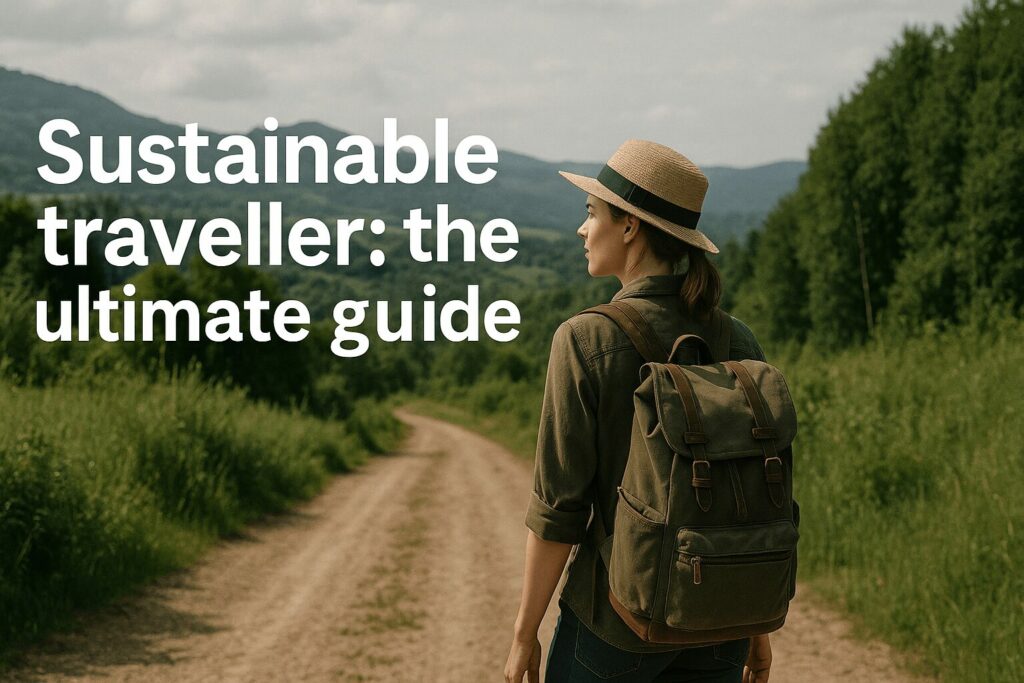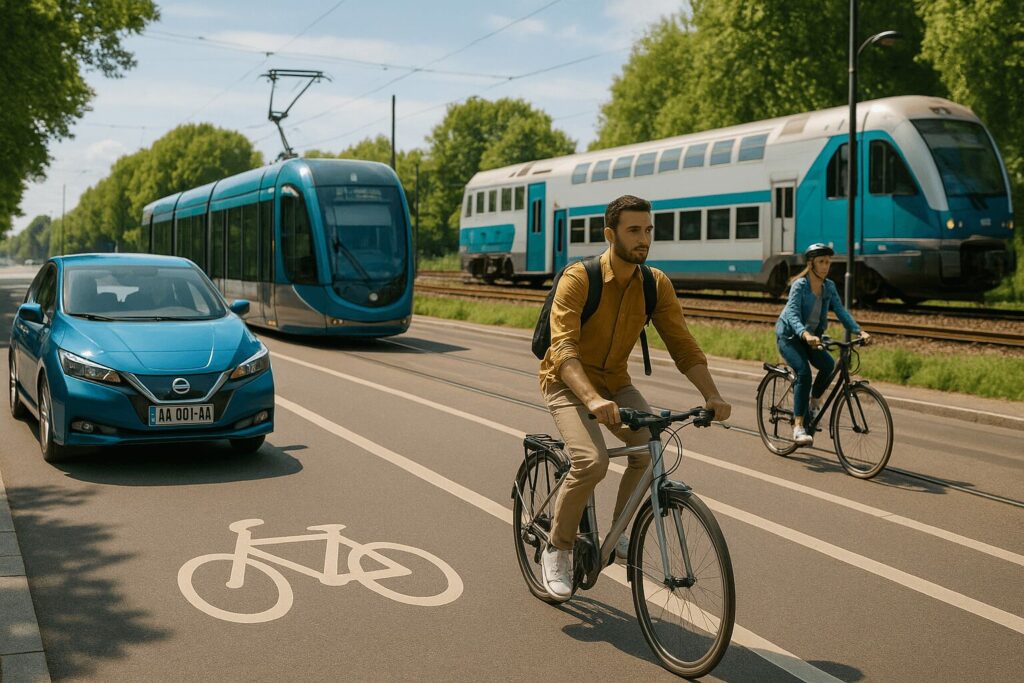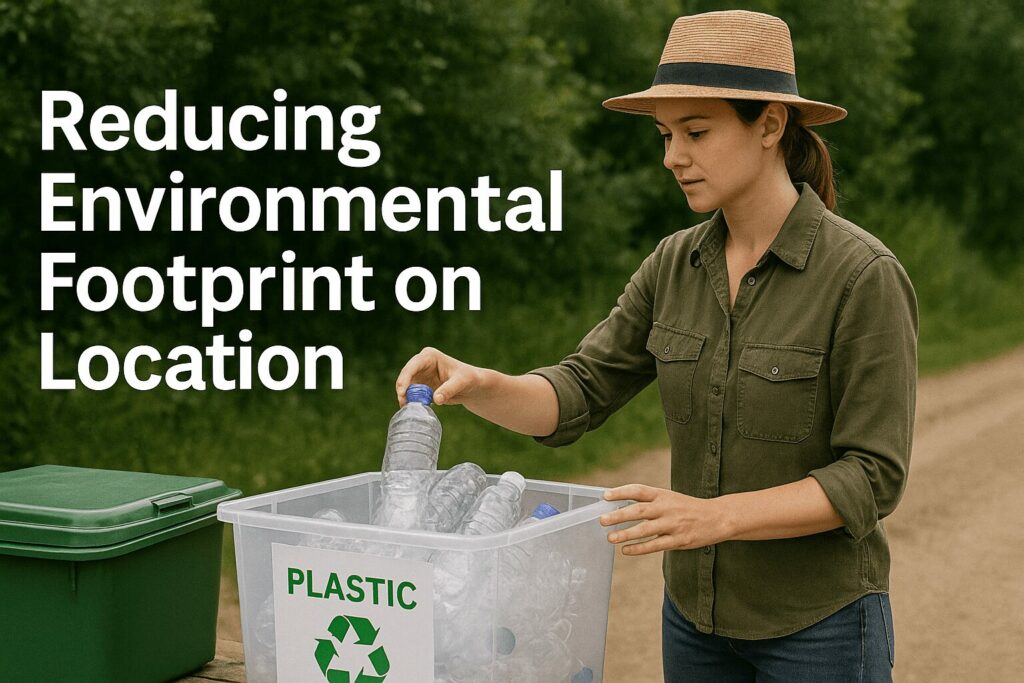
Become a Sustainable Traveller: Eco Tips for Low-Impact Tourism
Ever wondered how being a sustainable traveller can transform your adventures without harming the planet? 🌍 While travel opens doors to new cultures, it often leaves a heavy carbon footprint and strains local communities. This guide breaks down the basics consideration of a sustainable traveller, from reducing emissions to supporting local economies. You can then explore responsibly and ethical travel like a pro. Ready to wander smarter? 🚀
Article Takeaways
Here are the 5 pillars of a perfect sustainable traveller:
- Choose low-emission transport like trains, biking, or shared rides to cut your carbon footprint.
- Support local economies by booking family-run stays, hiring local guides, and buying handmade goods.
- Respect cultural heritage by learning local customs, dressing appropriately, and avoiding exploitative tourism.
- Stay in certified eco-accommodations and reduce resource use (energy, water, plastic) during your trip.
- Offset remaining emissions through verified programs—but always prioritize reduction first.
Table of contents
- What Is a Sustainable Traveller?
- Low-Impact Transportation Choices
- Supporting Local Economies
- Respecting Cultures and Heritage
- Choosing Sustainable Accommodation
- Reducing Environmental Footprint on Location
- Carbon Offsetting for Travel Emissions
- Researching Sustainable Travel Options
What Is a Sustainable Traveller?
A sustainable traveller prioritizes minimizing negative impacts on the environment and local cultures while maximizing positive contributions to communities. Unlike regular tourists focused on personal enjoyment, they aim for balanced experiences that support ecological preservation, cultural respect, and economic growth. Think of it as travel that leaves places better than you found them 🌱.
According to the UNWTO, the three pillars of sustainable travel—environmental, social, and economic responsibility—guide every decision. Environmental practices reduce carbon footprints through eco-friendly choices. Social responsibility respects local traditions, while economic efforts boost community income. Together, they create a travel style that’s as mindful as it is memorable 🌍.
By traveling sustainably, we protect natural resources and cultural heritage for future generations. Without it, overtourism strains ecosystems, erodes traditions, and exploits local economies. Simple actions like reducing waste or supporting small businesses make a world of difference. The stakes? Nothing less than the planet’s future 🌎.
Here’s what sets sustainable travellers apart:
- Prioritizes low-impact transport like trains or biking to cut emissions
- Uses reusable items (water bottles, shopping bags) to slash plastic waste
- Chooses eco-certified accommodations with proven green practices
- Boosts local economies by dining at family-run spots and buying handmade souvenirs
- Practices resource conservation through mindful energy and water use
More people are becoming sustainable travelers as climate concerns grow. A Euromonitor report found 41% of global travelers prioritize sustainable options despite costs. Destinations like Costa Rica and New Zealand lead by example, proving that eco-conscious choices can reshape tourism 🌿.
Real-world examples show how sustainability, especially hospitality sustainable practices create ripple effects. Bhutan’s carbon-negative model and community-led projects worldwide prove small actions scale. From supporting local guides to eco-volunteer work, these choices preserve cultures, create jobs, and protect ecosystems. Proof that mindful travel isn’t just a trend—it’s a movement 🌏.

Low-Impact Transportation Choices
Transportation accounts for 70% of travel’s carbon footprint. 🚗💨 Short flights and solo car journeys hit hardest, while trains, buses, and bikes slash emissions. For example, a 172km car ride adds 37.4kg of CO₂, but a bike emits just 0.03kg. As sustainable traveler, your ride choice makes a massive difference.
Trains are eco-rockstars! 🚆🌍 A London-Madrid trip by train clocks 43kg CO₂ vs 118kg by plane. Eurostar’s Paris-London route cuts emissions by 90% compared to flying. Short-haul routes like Paris-Bordeaux (4.4kg CO₂) or scenic U.S. lines (Coast Starlight) prove trains are green and scenic.
Some airlines actually care about the planet. ✈️🌱 SAS, KM Malta, and LOT Polish lead the pack, while United aims for net-zero by 2050. Look for sustainable aviation fuel (SAF) use—it slashes emissions up to 80%. Still, flying stays dirty—prioritize ground travel when possible.
Walking, cycling, and public transit keep cities breathable. 🚶♂️🚲 Euro cities like Copenhagen (400km bike lanes) let you explore without polluting. Buses and trams cut local air pollution (5% of total) and give you that « local vibe. » Plus, you’ll dodge traffic jams and parking fees!
Sharing rides or going electric? Both work! 🚙⚡ BlaBlaCar’s carpooling cuts emissions per person, while electric shuttles at events avoid fossil fuels. Stats show shared cars replace 5-8 private ones. EVs need accessible charging, but they’re a solid option for eco-conscious road trippers.
Plan smart trips! 🗺️🌍 Prioritize train routes (Europe’s TGV or France’s Loire Valley by bike) to cut emissions 10x vs flying. Slow travel—staying 3+ nights—boosts local economies and your budget. Families slash costs 60% with campervans and car-free adventures like hiking or kayaking. Win-win! 🌿
Supporting Local Economies
Tourism dollars can make or break local communities. 🏙️ In Barcelona, visitor spending boosts GDP but skyrockets rents, pushing residents out. Globally, tourism fuels 10% of economic activity—when done right, it funds schools, preserves heritage, and creates jobs. But poorly managed, it turns cities into theme parks for tourists only. Balance is key. 💡
Spotting true local businesses gets easier with Yelp or community events. 📍 For every $1 you spend locally, 68¢ stays in the community. France’s 53% commercial lodging stat shows how tourism shapes local economies. Skip chain hotels—opt for family-run guesthouses and restaurants instead. Your wallet speaks volumes. 💸
Local guides offer insider access and keep cash flowing where it’s needed. 🗺️ Madagascar’s Tsiky Tour crafts authentic experiences at fair prices. They even partner with European agencies, proving local expertise matters. Plus, they know hidden gems no global brand would find. Win: better trips + thriving communities. 🤝
Ethical souvenirs shouldn’t cost the earth—or exploit people. 🛍️ Think handmade Peruvian jewelry, Indian textiles, or Kenyan coffee. These items use local skills and materials, creating livelihoods. That $100 spent there keeps $68 in the community. Skip trinkets from faceless factories—go for stories over souvenirs. 🪡
Check these community tourism highlights around the globe, famous among sustainable travelers community:
- Rajasthan’s homestays let you sleep in heritage homes while supporting families
- Kenya’s Maasai-run conservancies protect wildlife and culture
- Vietnam’s bamboo basket boat workshops fund coastal communities
- India’s 4.3M handloom weavers keep traditions alive through your purchases
Volunteer smart—skip orphanages where 80% of “orphans” have families. 🚫 Orphanage tourism fuels exploitation. Instead, join IVHQ’s carbon-neutral programs supporting UN goals. Even better? Just spend intentionally—dine locally, hire guides, and pay park fees. Small acts create lasting impact. 🌍
Respecting Cultures and Heritage
Tourism can either preserve or erode local cultures. 🌍 At Uluru, 30% of visitors ignore Anangu requests not to climb the sacred rock. To be a Sustainable traveller means respecting traditions, not turning heritage into a photo op. Your choices protect cultural identity and support communities financially. Let’s explore how to do this right.
Research cultural dos and don’ts before you go. 📚 The “OK” hand gesture means “zero” in France but is offensive in Brazil. With 3,800 unique cultures globally, a quick guidebook scan prevents blunders. Apps like Culture Trip or government websites help. Even learning “hello” and “thank you” avoids awkward moments. No excuses, right? 😅
Follow local etiquette at sacred sites. 🕉️ In Japan, bow slightly when passing a Torii gate. Avoid touching religious relics or taking selfies during rituals. In 2021, 1,384 anti-religious acts were reported—don’t contribute! Dress modestly in temples, churches, or mosques. When in doubt, observe locals and mirror their behavior.
Ask before snapping photos of people. 📸 Photographer Art Wolfe always seeks consent, turning strangers into friends. On social media, highlight local businesses instead of overcrowded spots. 65% of travelers plan via Instagram—use that power wisely! Share tips on eco-friendly stays or ethical tours. Small actions = big impact. 📈
Basic phrases go a long way! 🗣️ “Bonjour” and “merci” in France, or “kia ora” in New Zealand. Locals appreciate the effort, and you’ll earn smiles. It’s not just polite—it opens doors to hidden gems. A sustainable traveler doesn’t needs Google Translate when kindness speaks universal! 😄
Try Quebec’s cheese-making workshops or France’s blueberry musée. Cultural tourism generates 40% of global tourism revenue and jobs. In Spain, join locals for Three Kings Day parades instead of tourist traps. These experiences keep traditions alive while supporting communities. Now that’s travel with purpose! ✨
Choosing Sustainable Accommodation
Hotels and homestays all leave footprints through energy, water, and waste. 🌱 A standard hotel night creates 10.5kg of CO₂ and uses 178 liters of water. Modular builds cut construction waste, while bans on mini shampoo bottles (like in California) slash plastic. Small changes? They really add up! 💧
Look for eco-certifications like Green Key, Green Globe, or GSTC—they’re your green travel cheat codes! 🎟️ Over 7,900 properties worldwide sport Green Key. EU Ecolabel and EMAS get extra points for third-party checks. 90% of Europeans trust these verified labels. Proof that sustainability can be standardized.
Local stays keep your cash local, unlike global chains that siphon profits away. 🏡 France’s Columbus Hotel Monte Carlo serves regional dishes, while Cape Town’s Silo Hotel showcases local art. 50% of travelers crave authentic experiences—your bed can double as cultural immersion. Win-win! 🤝
Watch for plastic-free policies, solar panels, and local supply chains. 🌿 A sustainable traveler avoid “green” claims without proof—real eco-hotels share concrete actions. 83% of global travelers demand sustainability. If they’re not cutting waste or tracking energy, they’re probably just eco-washing. Stay sharp! 🔍
Try treehouses, yurts, or farm stays for eco-chic vibes! 🌳 GreenGo’s Tiny Stays use 100+ eco-criteria. Workaway connects you with Mongolian yurt stays or French goat-cheese workshops. 97% of guests love these unique stays. Spoiler: they’re way more Insta-worthy than chain hotels. 📸
Bring a reusable kit (bottle, bags), reuse towels, and switch off lights. 💡 Hotel energy guzzles 241 kWh/m²/year in France alone. Simple habits? They’re gold. Think of it as travel karma—small acts make a huge difference. 🌎
Here’s how to spot real eco-hotels:
- Check certifications like LEED or EU Ecolabel—they’re legit
- Ask about waste management, not just “eco-friendly” vibes
- Prioritize properties using local ingredients and staff
- Avoid places that “go green” only by asking guests to reuse towels
- Support places investing in solar panels or water-saving tech

Reducing Environmental Footprint on Location
Daily choices matter most. 🌍 Transport, waste, and water usage hit hardest. Flights and single-use plastics top the list. Transport alone creates 75% of travel emissions. Small swaps—like reusable bottles or train rides—cut your impact fast. Prioritize these habits to keep destinations thriving.
Pack reusables! 💧 Bottles, bags, solid toiletries. 30M plastic bottles hit landfills daily. San Pedro La Laguna’s plastic ban uses rubber baskets instead. Avoid straws, request drinks without. Your kit = less trash, more space for memories. ♻️
Save water everywhere! Short showers, reused towels, eco-hotels. Tourists use 230L/day vs. 149L at home. Gorges du Verdon’s 2022 drought proves why. Turn off taps, reuse bottles. Every drop matters! 💧
Wildlife rules: a sustainable traveller observe, but don’t interact. 🐾 Keep distance, never feed or ride animals. 110M visit cruel sites yearly. Skip elephant rides or dolphin swims. Chiang Mai’s rescue centers show better ways to connect with nature. Be part of the solution.
Trash smartly! Take non-recyclables home. Nomad Adventure’s 4x4s have bins for proper sorting. France recycles just 50% of plastic bottles. Your mess, your responsibility. ♻️ Sustainable travelers never leave anything behind!
Energy hacks: pack light, plan efficient routes. 🚆 Light luggage cuts fuel use. Train over flights—65:1 CO₂ savings. 75% of travel emissions come from transport. Small changes = big difference. Travel smart, travel green!
Carbon Offsetting for Travel Emissions
Carbon offsetting funds projects that store or reduce greenhouse gases to balance unavoidable emissions. 🌳 A single credit equals 1 tonne of CO₂ avoided. For example, flying NYC to London creates 234kg of CO₂ per passenger—buying offsets for reforestation in Panama balances that impact. It’s like paying it forward for the planet. 🌍
Offset programs fall into nature-based (reforestation, wetland restoration) and non-nature-based (renewables, waste management). 🌱 Nature-based projects capture carbon long-term, like mangroves in Nigeria. Non-nature projects, like wind farms, cut emissions at the source. Both aim for measurable, verifiable results. Choose what aligns with your values! 🌿
Calculate emissions using tools like ADEME’s calculator or airline calculators. 🧮 For flights, include distance, class, and fuel type. Example: a Los Angeles-NY round-trip emits 1.1MT CO₂e. A 5-night Bali resort stay adds 1.0MT. Tourism causes 9% of global emissions—track your share before offsetting. 📊
Pick programs with certifications like Gold Standard or Verra. 🔍 These ensure additionality (projects wouldn’t exist without offsets), permanence, and transparency. 90% of Verra’s forest credits failed climate impact checks—stick to verified projects. Label Bas Carbone in France offers trusted local options. Do your homework! 🔎
Offsets aren’t perfect. 🚫 In Turkey, 90% of 11M trees planted in 2019 died due to poor planning. 90% of Verra’s forest credits were “phantom pollution” per a 2023 study. Offsets shouldn’t excuse flying—prioritize reduction first. Think of it as a last resort, not a free pass. 🌐
Some travel companies integrate offsets. 🌐 Natural Habitat Adventures has been carbon-neutral since 2007, covering client flights. Voyages Traditours plants trees via Compensation CO2 Québec. While 77% of tourism emissions come from transport, these programs help—but they’re not magic. Pair with other eco-choices for real impact. 🌎
Researching Sustainable Travel Options
Finding genuine sustainable travel options feels like a treasure hunt sometimes. To be a real sustainable taveler is not that easy🕵️♂️ Greenwashing tricks abound—like a Bali eco-hotel caught next to a trash pile or Lufthansa fined for fake eco-ads. Even worse? 300k fines for misleading claims show how serious this is. Spoiler: not all that glitters is green! 💸
Look for these legit certifications:
- GSTC for globally verified standards
- Green Key for eco-certified hotels (over 7,900 worldwide!)
- EU Ecolabel for EU hotels with third-party checks
- Green Globe for holistic sustainability
- EMAS for strict EU environmental management
Sustainable traveler pro tip: Always double-check their claims online—transparency matters! 🔍
Being a sustainable traveller isn’t just about ticking boxes—it’s about mindset shifts! 🌍 Start by choosing low-impact transport (trains over flights!), supporting local businesses, and respecting cultures. Small steps add up—imagine future explorers experiencing the same vibrant destinations you love. Ready to redefine your eco-friendly travel? ✈️ Your choices shape the planet’s story.
Q / A About Becoming a Sustainable Traveller
Most sustainable travel option?
Alright, let’s talk about the *most sustainable travel option* out there, and it’s a clear winner: *train travel*. This mode of transport is hailed as the ultimate eco-friendly alternative to drastically *cut down your carbon footprint* and overall impact on our beautiful planet. Think of it as a smart choice for both your adventure and Mother Earth! 🌍 Seriously, trains are *eco-rockstars*! For example, a trip from London to Madrid by train clocks in at significantly less CO2 compared to flying, and routes like Paris-London on Eurostar slash emissions by a massive 90%. So, if you’re looking to *wander smarter* and truly make a difference, hopping on a train is absolutely the way to go.
What are sustainable travel types?
So, what exactly are we talking about when we say « sustainable travel types »? Well, it’s a whole spectrum of ways to explore that aim to *minimize negative environmental and cultural impacts* while really *boosting local communities*. It’s about being a mindful explorer, making sure your adventures leave places better than you found them. 🌱 This big umbrella includes things like *ecotourism*, which is all about responsible travel to natural areas, and *slow travel*, where you take your time, perhaps by train or bike, to really immerse yourself. You’ve also got *ethical and solidarity tourism*, ensuring your travel dollars directly benefit local businesses and artisans. It’s all about making conscious choices, from your transport to your accommodation, to ensure a positive ripple effect.
